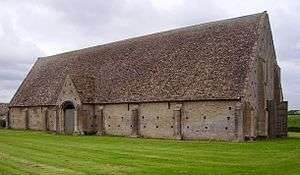Great Coxwell Barn

Great Coxwell Barn is a large 14th-century barn on the northern edge of the village of Great Coxwell, in Oxfordshire, England, though formerly in Berkshire. It is located in the Vale of White Horse near the market town of Faringdon.
Name and use
There is some dispute about the name of the barn: although nearby (old) signposts direct visitors towards the Great Coxwell Tithe Barn, the visitor's guide Munby (1996) published by the National Trust (the owner since 1956) is entitled Great Coxwell Barn.
When it was built, it was as part of a monastic grange under the control of Beaulieu Abbey, in Hampshire. As such the barn would have been used to store most, if not all, of the crop of the grange. Also crops were received, as tithes, to Beaulieu Abbey as rent from tenant farmers, for acreages owned by the Abbey. Beaulieu Abbey collected these tithes from tenant farmers and parishioners, who were obliged to deliver a portion of their crop to the barn. These tithes were recorded by a clerk who had his office inside the west door.
Since the barn is very large—the internal measurements of the main "hall" being 144 feet (44 m) by 38 feet (12 m)—it could be argued that the barn should be named the Great Barn - Great Coxwell. The barn is one of a number of barns termed great barns in Aston (2000):
The real glories are however the great barns (erroneously called tithe barns or by estate agents tythe [sic] barns). These were the warehouses of the Middle Ages where vast quantities of food was [sic] stored, and they show the skill and craftsmanship of the medieval workman at its best. The biggest are enormous – Bradford on Avon and Tisbury, Wiltshire, Great Coxwell in Oxfordshire ... (p107).— Aston
It is also noted as a favourite of the well known poet William Morris who described the Barn as "unapproachable in its dignity". He would often bring guests to marvel at its splendour.
History

The barn was part of the manor of Great Coxwell which was attached to the manor of Faringdon. This was originally a Royal manor given to the Cistercian monks by King John in 1203 for the founding of an abbey. The manor house or grange at Coxwell is believed to have stood opposite Court House Farm. The centre of Faringdon Manor was at Wyke, a now lost grange and site of the abbey, just north of the town. The abbey moved to Beaulieu, Hampshire in the New Forest but Faringdon and its granges remained under its control. The barn is now in the care of the National Trust.
Structure
The barn, built in the first decade of the 14th century, is constructed of Cotswold stone and the roof is constructed of Stonesfield slate. The barn is aisled, to support the massive roof. There is a dovecote over the door of the east porch. The floor area is 5,502 square feet (511.2 m2).
Also note the interesting carved graffiti on the stone structural supporting columns. Similar carvings can be found in the local parish church of St. Giles.
Gallery
This gallery shows general views of the Great Barn.
 The Great Barn from roughly SW
The Great Barn from roughly SW The southern-gable
The southern-gable Interior showing western aisle
Interior showing western aisle Interior showing roof structure
Interior showing roof structure
Sources
- Sue Clifford and Angela King, England in Particular (London: Hodder & Stoughton, 2006), ISBN 0-340-82616-9, pp. 410–411.
- Timothy Darvill, Paul Stamper and Jane Timby, England: An Oxford Archaeological Guide to Sites from Earliest Times to AD 1600 (OUP, 2002), ISBN 0-19-284101-7, pp. 285–6.
- F.W.B. Charles, The Great Barn at Bredon (Oxbow Monographs 76; 1997), ISBN 1-900188-27-9, pp. 14–16.
- Aston, Mick (2000), Mick's Archaeology, Tempus Publishing Ltd, Stroud, Gloucestershire.
- Munby, Julian (1996), Great Coxwell Barn, The National Trust (Enterprises), Swindon, Wiltshire.
External links
| Wikimedia Commons has media related to Great Coxwell Barn. |
- exterior photograph
- interior photograph
- The National Trust
- Beaulieu Abbey history
- Photos of Great Coxwell Barn on geograph.org.uk
Coordinates: 51°38′39″N 1°36′46″W / 51.64416°N 1.61264°W